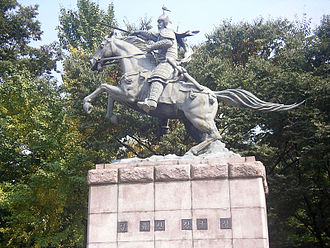이름과 족보
참고사이트들
|
|
Mid-Progenitor General Kim Yushin Much of what we know about his life comes from the detailed account in the Samguk Sagi, Yeoljeon 1-3, and the much briefer record in the Samguk Yusa, vol. 1. Kim Yushin was the son of General Kim Seohyeon and Lady Manmyeong, who was a daughter of King Jinheung of Silla. He was born in Gyeyang, Jincheon County in 595, became a Hwarang warrior at just 15 and was an accomplished swordsman and a Gukseon (, ; Hwarang leader) by the time he was 18 years old. By the age of 34 he had been given total command of the Silla armed forces. Kim's first military engagement in command is believed to have occurred around 629 AD, and through it he quickly proved his capabilities as a warrior.
Throughout his life Kim Yusin had felt that Baekje, Goguryeo, and Silla should not be separate countries but united. He is regarded as the driving force in the unification of the Korean Peninsula, and is the most famous of all the generals in the unification wars of the Three Kingdoms. Kim Yusin was rewarded handsomely for his efforts in the campaigns. In 668, King Munmu bestowed upon him the honorary title of Taedaegakgan (태대각간, 太大角干), something like "Grand Sub-Chief." He reportedly received a village of over 500 households, and in 669 was given some 142 separate horse farms, spread throughout the kingdom. He died four years later, leaving behind ten children. Kim Yusin lived to the age of 79 and is considered to be one of the most
famous generals and masters of Korean swords in Korean history. He is the
focus of numerous stories and legends, and is familiar to most Koreans from
a very early age. Following his death in 673, General Kim was awarded the
honorary title of King Heungmu. Kim Yusin was 15 when he became a Hwarang and 18 when he became Master of
the sword and a Kuksón. By the time of his death he was one of the most
powerful men in Korea and was buried like a king. From King Húngdók (826-836) Kim Yusin was later awarded the posthumous title
of "Great King Húngmu" (Húngmu Taewang - great king promoting the martial
arts).
Tomb of General Kim Yu-sin in Gyeongju
|
|
|
|
General Kim Yu-shin|Story
Club -Korean exhibition of great men
|
|
|
Progenitor of 4 Million Gimhae Kim Clan
Family Tree Table Progenitor to Mid-Progenitor GimhaeKim Family Tree Table 1-78
Links
|
||||
Heo Hwang-okWikipedia
|
||||
|
|


